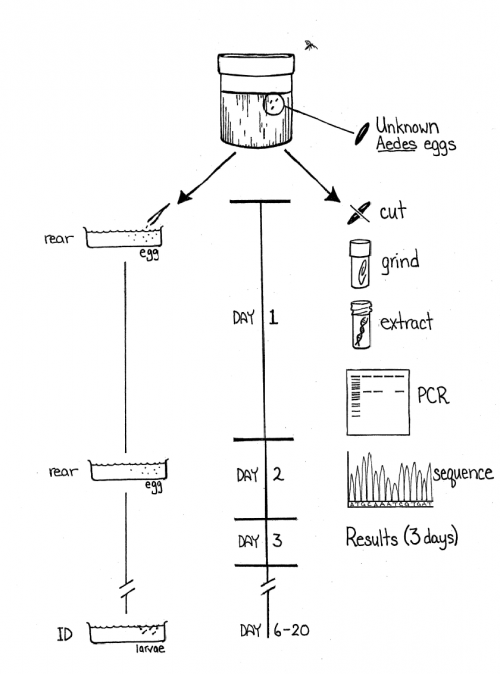Aedes aegypti Surveillance

The District conducts intensive surveillance for invasive Aedes mosquitoes during the summer months. The surveillance program mainly targets two container-breeding species, Aedes aegypti and Aedes albopictus, which have been increasing their range within California over the last several years. The presence of these mosquitoes is highly undesirable because they are aggressive human biters and also can transmit diseases including dengue, chikungunya, yellow fever and Zika. Although none of those diseases are locally-transmitted in California at this time, these mosquitoes are relentless biters and can be very annoying.
The District surveillance program consists of special traps that target mosquitoes that lay eggs in containers. The majority of these traps are located at cemeteries, nurseries and other areas of elevated risk of introduction or colonization, distributed throughout San Mateo County. Additional traps are concentrated in areas of past invasive Aedes mosquito detections in Menlo Park and Atherton. Most traps are set seasonally from May through October, but some traps are maintained year-round. Additional invasive Aedes trap sites were added in 2020 in Pacifica, Daly City and Redwood City.

Ovicup traps, the most commonly used traps in this surveillance program, are small black cups or buckets filled about half-way with water. A sheet of seed germination paper lines the inner surface of each cup. The water and black coloration of the trap attracts container-breeding invasive Aedes mosquitoes. They deposit eggs on the seed germination paper. The papers are collected weekly, replaced, and checked in the laboratory for eggs.

When eggs are collected in an ovicup, the District can determine the species of mosquito that laid them using an in-house DNA “barcode” test. In this test, DNA is extracted from the eggs and purified using a lab process called polymerase chain reaction (PCR). The PCR product is then sent to a local biotechnology company for DNA sequencing. The DNA sequence is sent back to the District and matched to an online database which allows us to determine the species of the mosquito with a high degree of certainty. This test has greatly increased the speed in which we can identify invasive mosquitoes and doesn’t require raising mosquito eggs to maturity, which has a high failure rate and can take several weeks. Because invasive Aedes mosquitoes in nearby counties pose a threat to San Mateo County, the District lab has also conducted these DNA barcode tests on mosquito eggs or damaged mosquito specimens to assist other neighboring vector control districts.
Another important aspect of the District’s invasive mosquito surveillance program is imported disease case investigation. When the District is sent a report of a travel-related mosquito disease case from the San Mateo County Health Department, we conduct additional mosquito surveillance in the neighborhood. This surveillance includes both ovicups and BG-Sentinel traps. A BG-Sentinel trap is an adult mosquito trap that includes a scent lure attractive to mosquitoes that prefer human blood. These traps target invasive mosquito species that are capable of transmitting imported diseases. Any invasive mosquitoes collected in a BG sentinel trap can be tested for the presence of imported pathogens.
To date, the District has not detected any invasive vector mosquitoes in the vicinity of travel-related disease cases.
Page last reviewed: March 5, 2024
